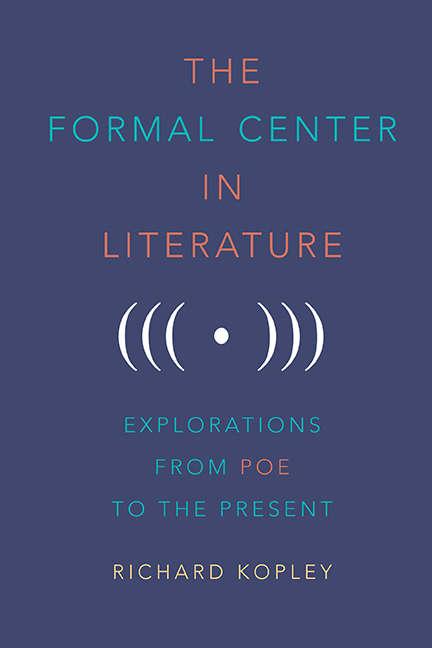Book contents
- Frontmatter
- Dedication
- Contents
- Acknowledgments
- Introduction
- 1 “Mournful and Never-Ending Remembrance” in Edgar Allan Poe's The Narrative of Arthur Gordon Pym
- 2 Retracing Our Steps in Edgar Allan Poe's “The Man of the Crowd”
- 3 “Scrutinizing the Parchment More Closely”: The Form of “The Gold-Bug” and Its Relationship to That of the Dupin Tales
- 4 Form and Reform in Nathaniel Hawthorne's “Earth's Holocaust”
- 5 The Circle and Its Center in Herman Melville's “Bartleby, the Scrivener”
- 6 Chiasmus in Henry David Thoreau's Walden
- 7 The Mythological Centers of Lewis Carroll's Alice Books
- 8 Table as Text in James Joyce's “The Dead”
- 9 The Structure of Sherwood Anderson's “Hands”
- 10 The Architecture of Ernest Hemingway's “The Three-Day Blow”
- 11 Balance in Dashiell Hammett's The Maltese Falcon
- 12 Framing Caesar in Raymond Chandler's The Big Sleep
- 13 The Ridge of the Domino in Patricia Highsmith's Strangers on a Train
- 14 The “X in the Air” in Joyce Carol Oates's “Where Are You Going, Where Have You Been?”
- 15 The Hybrid Center of Zadie Smith's White Teeth
- Notes
- Bibliography
- Index
7 - The Mythological Centers of Lewis Carroll's Alice Books
Published online by Cambridge University Press: 14 June 2019
- Frontmatter
- Dedication
- Contents
- Acknowledgments
- Introduction
- 1 “Mournful and Never-Ending Remembrance” in Edgar Allan Poe's The Narrative of Arthur Gordon Pym
- 2 Retracing Our Steps in Edgar Allan Poe's “The Man of the Crowd”
- 3 “Scrutinizing the Parchment More Closely”: The Form of “The Gold-Bug” and Its Relationship to That of the Dupin Tales
- 4 Form and Reform in Nathaniel Hawthorne's “Earth's Holocaust”
- 5 The Circle and Its Center in Herman Melville's “Bartleby, the Scrivener”
- 6 Chiasmus in Henry David Thoreau's Walden
- 7 The Mythological Centers of Lewis Carroll's Alice Books
- 8 Table as Text in James Joyce's “The Dead”
- 9 The Structure of Sherwood Anderson's “Hands”
- 10 The Architecture of Ernest Hemingway's “The Three-Day Blow”
- 11 Balance in Dashiell Hammett's The Maltese Falcon
- 12 Framing Caesar in Raymond Chandler's The Big Sleep
- 13 The Ridge of the Domino in Patricia Highsmith's Strangers on a Train
- 14 The “X in the Air” in Joyce Carol Oates's “Where Are You Going, Where Have You Been?”
- 15 The Hybrid Center of Zadie Smith's White Teeth
- Notes
- Bibliography
- Index
Summary
ALICE SAYS TO HER CAT at the end of Through the Looking-Glass and What Alice Found There, “Tell me, Dinah, did you turn to Humpty Dumpty? I think you did—however, you'd better not mention it to your friends, just yet, for I'm not sure.” Martin Gardner asks at the end of his edition of the Alice books, The Annotated Alice, “Why did Alice think Humpty was Dinah?” He cites what he terms “an ingenious theory”—that even as Humpty Dumpty spoke to a king, a cat may look at a king. He also mentions an essay that observes that the name “Dinah” begins and ends with the initials of Humpty Dumpty reversed (271n2). Still, the question remains an open one.
I will offer an answer, applying the center-centered approach that has already been advanced here. I will provide a new reading of the Alice books, one complementary to other readings, including analyses of Carroll's life (such as Morton N. Cohen's biography and elsewhere) and considerations of Carroll's reading (such as Ronald Reichertz's study and in other works). As in previous chapters, I will curve around from the whole to a part to the whole—or from a part to the whole to a part—the hermeneutic circle. A circle, it will be seen, is a singularly appropriate image for reading the Alice books. And the hermeneutic circle will take us on another adventure in Wonderland, one that will lead to a new key.
The Alice books are works of delicacy and whimsy—but they are also works of sturdy structure, of singular symmetry. We may consider first Alice's Adventures in Wonderland, proceeding from the outside in. An overview of that classic reveals repeated framing. We see in the opening poem about Carroll's first telling the story, four stanzas into the seven, the three Liddell sisters “In friendly chat with bird or beast— / And half believe it [“the tale”] true” (7). Then we see in the closing four paragraphs about Alice's sister's dream, at the beginning of the third paragraph, “So she sat on, with closed eyes, and half believed herself in Wonderland” (126). The word “half” in both cases—occurring half-way through the relevant passage—encourages the reader to think in terms of halves. The symmetrical phrasing in the two passages—“half believe” and “half believed”—confirms the evident framing.
- Type
- Chapter
- Information
- The Formal Center in LiteratureExplorations from Poe to the Present, pp. 62 - 68Publisher: Boydell & BrewerPrint publication year: 2018

